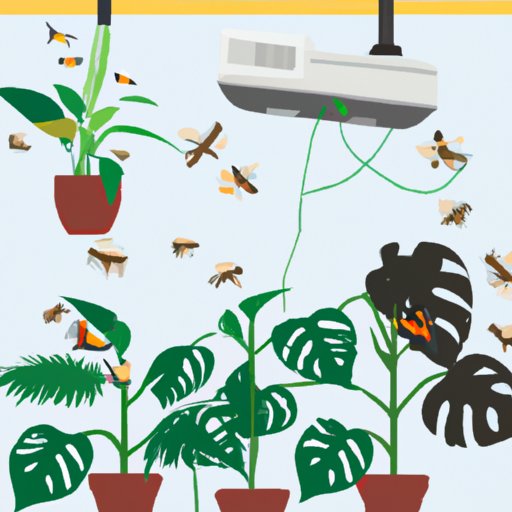Introduction
Having indoor plants is a great way to bring nature indoors and add some life to any living space. Unfortunately, one issue that many indoor plant owners may face is an infestation of flying bugs. These small pests can wreak havoc on your plants, causing them to wilt or even die if left unchecked. In order to ensure that your plants stay in the best possible condition, it’s important to understand how to get rid of flying bugs on indoor plants.
Flying bugs are generally small, winged insects such as aphids, whiteflies, fungus gnats, and mealybugs. They are attracted to light and moisture, and they feed off of the sap from the leaves of the plants. These bugs can spread quickly, so it’s important to act fast in order to prevent an infestation.
Sticky Traps
One of the easiest ways to get rid of flying bugs on indoor plants is to use sticky traps. These traps are made of glue-like material and are designed to attract and trap the bugs. You can purchase sticky traps at most garden stores or online. To use the traps, simply place them near the affected plants and leave them there until all of the bugs have been caught.
The benefit of using sticky traps is that they are easy to use and relatively inexpensive. Additionally, they do not require any chemicals or pesticides, making them a safe option for your plants. However, it is important to note that these traps will only catch the bugs that are already present, not those that are yet to arrive.
Trimming Leaves
In addition to using sticky traps, it is important to regularly trim the leaves of the affected plants. This will help to reduce the amount of food sources for the bugs, as well as minimize their hiding spots. When trimming the leaves, make sure to remove any yellow or wilted leaves, as these are signs of the bugs’ presence.
When trimming leaves, it is important to use sharp scissors or pruning shears. Dull blades can cause damage to the leaves and make them more susceptible to further infestations. Additionally, make sure to wash the blades with soapy water after each use to avoid spreading the bugs to other plants.
Increasing Humidity
Another effective way to get rid of flying bugs on indoor plants is to increase the humidity around the plants. Many flying bugs prefer dry conditions, so increasing the humidity can make the plants less attractive to the bugs. There are several ways to increase the humidity around your plants, including misting the leaves with water, placing a humidifier near the plants, or grouping the plants together to create a more humid environment.
It is important to note that increasing the humidity too much can also cause problems, so it is important to find a balance between too much and too little humidity. Additionally, make sure to keep an eye out for mold or mildew, as these can be caused by overly humid environments.
Insecticidal Soap/Neem Oil Solution
Insecticidal soap or neem oil solutions can also be used to get rid of flying bugs on indoor plants. Both of these solutions work by coating the bugs in an oil-based substance, which causes them to suffocate and die. To apply the solution, mix one tablespoon of insecticidal soap or neem oil with one gallon of warm water. Then, spray the solution onto the affected plants, making sure to cover all of the leaves and stems.
It is important to note that insecticidal soap and neem oil solutions can be toxic to humans and animals if ingested, so it is important to take proper safety precautions when handling and applying these solutions. Additionally, these solutions may need to be reapplied every few days in order to be effective.
Fan Installation
Installing a fan near the affected plants can also help to get rid of flying bugs. The fan helps to circulate the air around the plants, which can help to reduce the humidity and make the environment less attractive to the bugs. It is important to note that the fan should be installed at least two feet away from the plants in order to avoid damaging the leaves.
Additionally, the fan should be set to low speed, as high speeds can cause the leaves to dry out. Finally, make sure to clean the fan regularly, as dust and dirt can accumulate and make the environment more hospitable to bugs.
Vacuuming
Finally, vacuuming can be used to get rid of any visible flying bugs. To do this, simply use a vacuum cleaner with a hose attachment to suck up any bugs that you can see. Make sure to empty the canister or bag after each use to avoid spreading the bugs to other plants.
It is important to note that vacuuming is only effective for bugs that are visible. If there are bugs that are hidden, then other methods such as sticky traps or insecticidal soap/neem oil solutions may be necessary.
Conclusion
Getting rid of flying bugs on indoor plants can be challenging, but with the right strategies it is possible. Sticky traps, trimming leaves, increasing humidity, insecticidal soap/neem oil solutions, fan installation, and vacuuming are all effective methods for getting rid of these pesky bugs. Additionally, it is important to take preventative measures such as keeping the plants well-watered and free of debris to help avoid future infestations.


